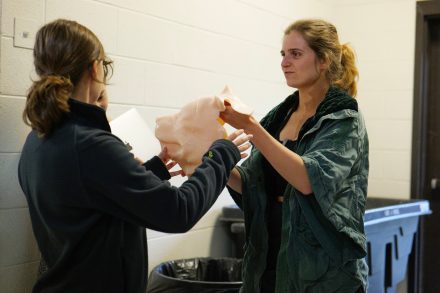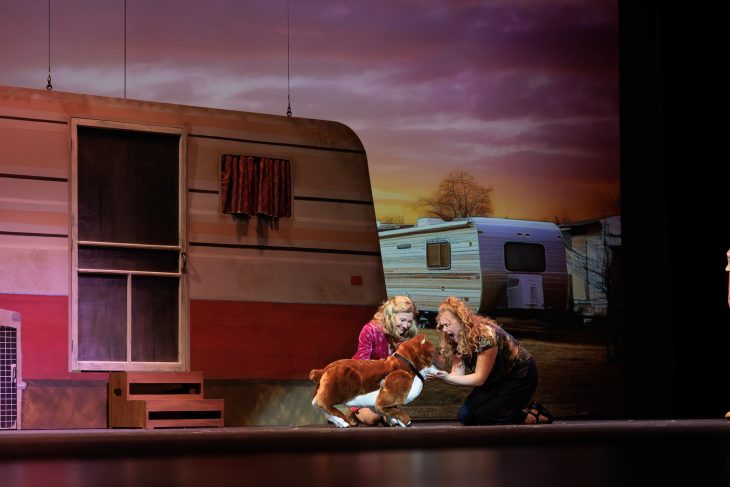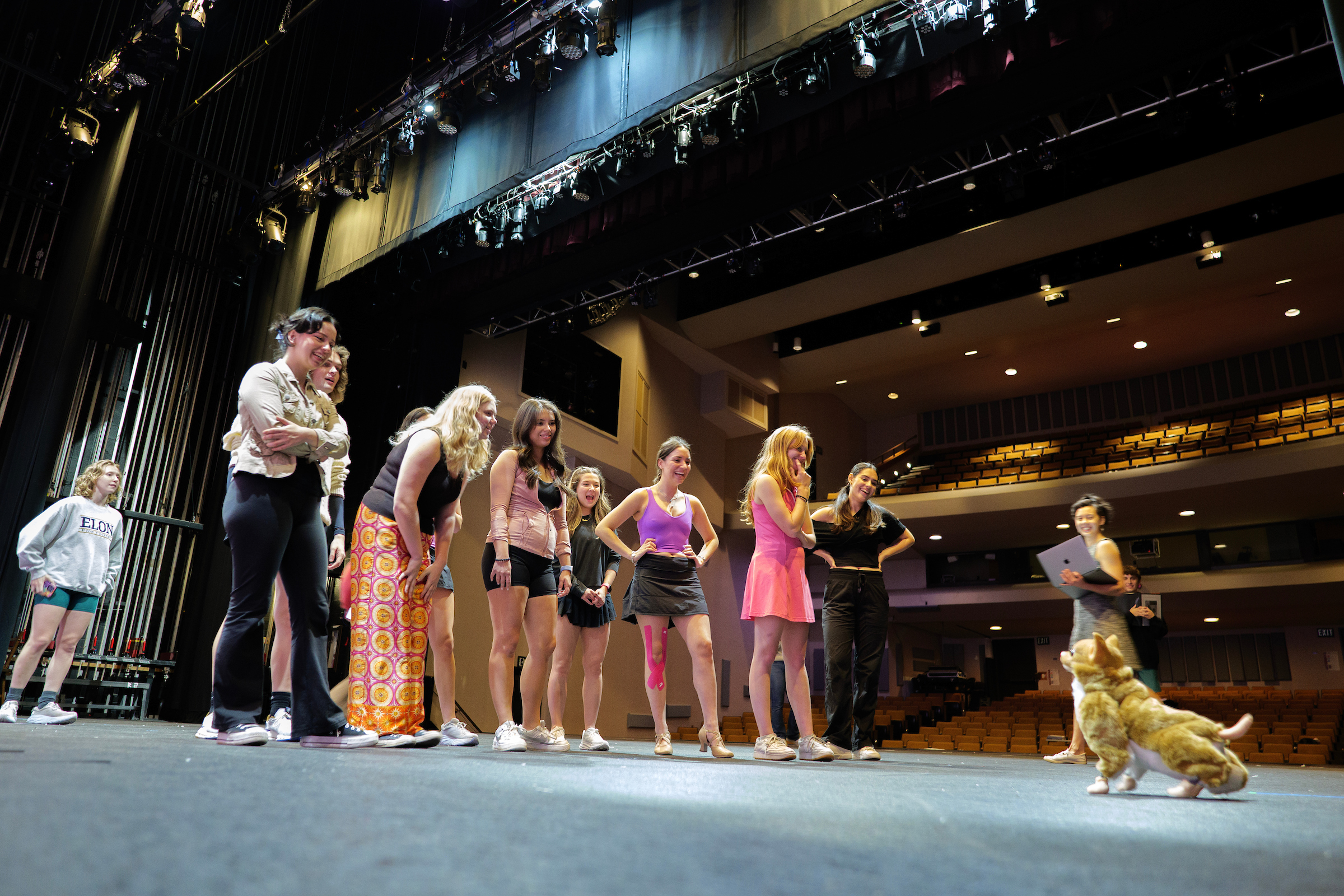Science and the arts converge at Elon as two departments team up to bring the canine characters in “Legally Blonde: The Musical” to life.
The dog was met with squeals of delight and applause when he walked onstage for the first time to greet his human co-stars. With the tap of his paws and a shake of his tail, he immediately breathed new life into the scene. During rehearsal breaks, actors remarked, “This is the coolest thing I’ve ever seen in my life!” and “I love science!” And that was before the dog even had fur or a face.
Elon’s fall production of “Legally Blonde: The Musical” didn’t feature live canine actors but instead employed two scene-stealing robotic dogs thanks to a unique collaboration between the Department of Performing Arts and the Department of Engineering.
Based on the 2001 movie starring Reese Witherspoon, “Legally Blonde” follows fashionista Elle Woods on her journey from UCLA to Harvard Law, shattering stereotypes and tackling harassment along the way. The film features two iconic dog characters: Bruiser, Elle’s sharply-dressed chihuahua, and Rufus, Elle’s friend Paulette’s beloved bulldog. The pair are typically portrayed by real dogs in the musical, but Assistant Professor of Music Theatre Courtney Liu, the show’s director, saw an opportunity for an innovative approach.
Liu and Assistant Professor of Engineering Blake Hament were friends as students at Duke University, and they reconnected when they both joined Elon’s faculty. She knew he was working on a research project involving robotic quadrupeds and joked that she needed some dogs for “Legally Blonde.” But that offhand remark quickly sparked the idea for a rewarding interdisciplinary partnership.
As it happens, Hament had been mentoring Zoe Scherpbier ’25 on making these robotic dogs more appealing — both visually and tactilely — so they’d move naturally and have fur that invites interaction, just like real dogs. He connected Liu with Scherpbier to see if she would be interested in designing the dogs’ look for a show like “Legally Blonde,” where aesthetics are key.
And thus began a collaboration that would transform how students and audiences view the intersection between STEM (science, technology, engineering and math) and the arts.
***

Hament has been studying applications for robotic dogs since 2018, when he worked with Boston Dynamics and Tesla to develop a quadruped that could be controlled via a virtual reality headset to perform factory shut-off procedures that would be dangerous for humans in an emergency. He is particularly interested in their potential as seeing eye dogs for visually impaired people who may not be able to have live dogs for a variety of reasons, from allergies to long-term expenses to lengthy wait lists for traditional service animals. But some find the mechanical appearance of robotic dogs off-putting, which presents some challenges. Hament has even heard of instances when people attacked robotic dogs out of fear after encountering them on the street in markets where the quadrupeds were being tested.
“There are a lot of really valid concerns around robotics, but if somebody is depending on this robot to navigate and be more independent out in public, the last thing we want is people messing with this robot or damaging it,” Hament says. “So how can we get from a creepy metal robotic skeleton to something that is more comfortable for everybody in public spaces?”
Hament spent summer 2024 working with Scherpbier on that very question. A mechanical engineering major with a minor in mathematics, Scherpbier has been sewing ever since her grandmother taught her as a child. She wanted to combine her passion for developing her own fabrics and materials with other aspects of engineering, so Hament immediately thought of her to help him explore artificial furs for robotic dogs.
Hament and Scherpbier experimented with different blends of materials, combining traditional weaving techniques with stainless steel fibers to connect the artificial fur to the dog. They even explored making the fur pressure sensitive, so the dog could “feel” when someone touched it and produce a pre-programmed reaction, but decided to focus instead on making the dogs look as realistic and approachable as possible.
Hament and Liu received a grant through Elon’s Fund for Excellence in the Arts and Sciences, which fueled the project’s momentum with additional financing and resources. Liu connected Hament and Scherpbier with Eric Hart, who leads the master’s program in animatronics at the University of North Carolina School of the Arts and is married to Natalie Hart, associate professor, co-chair of Elon’s Department of Performing Arts and scenic designer for “Legally Blonde.” He and graduate student Carlitos Ayma Gonzalez agreed to participate in the project, taking the synergy between engineering and theatrical design a step further.

Scherpbier traveled to Winston-Salem once a week from June to October to work in the UNCSA facilities with Gonzalez in addition to the hours she spent conceptualizing the dogs’ appearance on Elon’s campus. She teamed with Gonzalez to design and fabricate silicone molds for the dogs’ faces and refine the artificial fur to meet the production’s aesthetic needs without impacting the robots’ functionality.
“I learned how to do certain things with CAD (computer-aided design) to make it look more realistic and smoother,” Scherpbier says. “I learned how to flock so we could get fur on the silicone face. I’ve learned a bunch of techniques that I wouldn’t have come across otherwise.”
***
The initiative was a collaborative effort across both departments from start to finish. Jack Delucco ’26, Maggie Dion ’26 and Amalie Keefe ’26 were already researching different aspects of robotic dogs when they boarded the “Legally Blonde” project. Dion explored artificial articulated ears that could allow the dogs to appear friendlier and more expressive. Keefe began developing an AI voice module to help the dogs process verbal commands, and Delucco researched electronics and radio frequency engineering. For the show, they worked together to develop and execute the dogs’ movements. Delucco programmed the controls, while Dion operated Bruiser and Keefe operated Rufus during the performances.

“(Rufus) spins around, and there are different modes where he can maneuver without walking, like downward dog pose,” Keefe says. “But we’re also well aware of the limitations that having so many different 3d-printed plates will have on him. So some of the more intricate moves that have been pre-programmed we’re not going to use because of movement limitation as well as battery life limitation.”
Liu and the engineering team engaged in a lot of troubleshooting to strike a balance between the robots’ capabilities and the stage direction in the script. Rufus is typically depicted as a bulldog, but he was a Pitbull mix in Elon’s production because that design was more conducive to the quadruped frame while still capturing the character’s spirit. In one scene, Bruiser was scripted to sit down, but the quadruped frame is wider than a real chihuahua, which makes operating the hind legs in the thick fur casing more difficult. So Liu pivoted to having him twirl instead.
“These are interesting challenges from an educational standpoint to solve as a group,” Liu says. “I think music theater and engineering have more similarities than we thought. There’s so much creativity happening with the creation of these robot dogs, and there is so much precision and logical thinking happening on the music theater side of things.”
Too often society says either you’re a technical person or a creative person, but the best work is when you get to do both.
From a production design standpoint, it was crucial for the dogs to look similar to their big-screen counterparts. But the fur suit made Rufus in particular run hot, which caused his already limited battery life to drain even faster. The engineering team had to secure enough batteries and perfect a highly precise process for prepping Rufus to ensure he could complete all his scenes on cue for the duration of each show.
“We can’t start (the robot) with any of the (fur) shells on, so we have to start it up, get the costumes on as fast as possible, get him out to do his thing, get him back, take everything off and power him down before he just wet spaghettis on the floor,” Scherpbier says.
Emily Stober ’25, who played Elle, says engaging with her robotic co-stars on stage was an interesting acting exercise as well. She has previously been in productions with live animals, and even with the help of professional handlers, canine actors can be unpredictable. “Having a robot dog keeps me in the world of the show a little bit more, because I don’t have to worry as much about if something is going to go wrong,” Stober says. “And because it’s being controlled by a person, they can do things that give us more to play off of. It’s like the perfect balance between having a live animal and having an inanimate object.”
***
Liu says Elon’s distinct experiential curriculum rooted in the arts and sciences makes it an ideal environment for this kind of interdisciplinary collaboration. Applying the robotic dog project to “Legally Blonde” gave the engineering and performing arts students a singular opportunity to engage with people they wouldn’t typically meet, and they gained a new appreciation for each other’s fields.
“We attract a very specific kind of student at Elon Music Theatre who is talented enough to be on Broadway and wants an education that’s well-rounded,” Liu says. “All of my students are extremely excited to be collaborating with engineering students and to make space for them backstage.”

The experience also opened the students’ eyes to new ways they can use their skills and combine their interests professionally. Scherpbier acted in theatrical productions in middle and high school, so using her engineering skills to support a musical felt like a natural progression. She now plans to apply to UNCSA’s animatronics master’s program, fusing her love for science and the arts.
“This has taught me that engineering and robotics can exist in unexpected places,” Dion adds. “I wouldn’t have thought I’d be involved in a play this year, but now I see that engineering can be in other parts of life. I don’t necessarily have to go to (a large engineering firm) to do robotics.”
Now that “Legally Blonde” has wrapped, Hament and Liu plan to document the experience in a research paper with student co-authors. Pooling resources and expertise allowed the engineering and performing arts teams to accomplish more together than they could on their own, and Hament and Liu hope to explore more possibilities for interdisciplinary collaboration in the future.
“Too often society says either you’re a technical person or a creative person, but the best work is when you get to do both,” Hament says. “You don’t have to silo all that. Everybody is using their full brain and their full personhood, and that’s really cool to see.”



